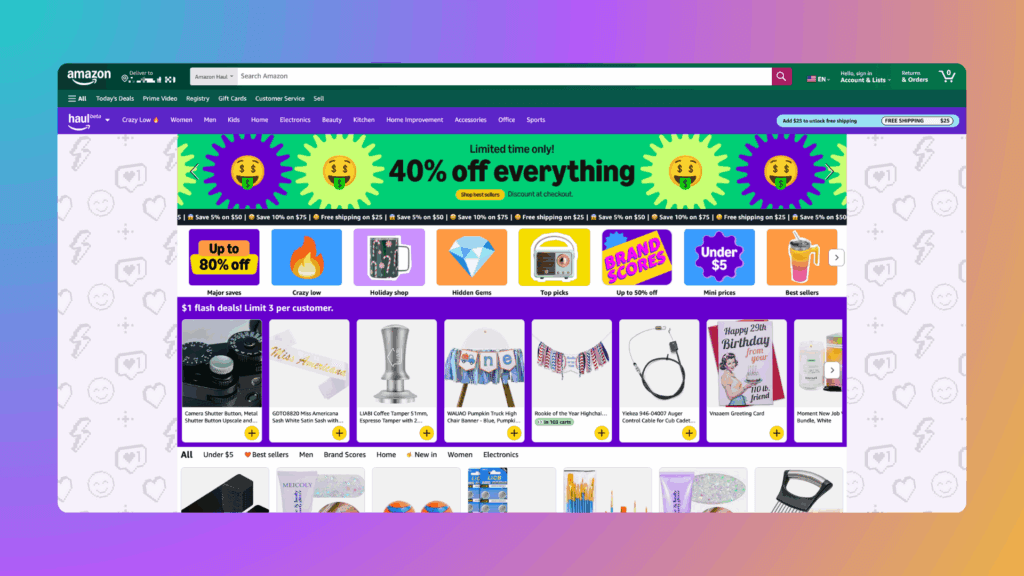- Blog
-
For Sellers
How can sellers join the Amazon Haul program?
Haul flips the Amazon playbook: no branding, tight price caps, and massive potential for sellers who can make the margins work.

Amazon launched Haul as a separate storefront targeting budget-conscious shoppers who want ultra-low prices on everyday items. The program creates opportunities for sellers who can consistently source and sell products under strict price caps while maintaining quality standards.
Unlike Amazon’s main marketplace, Haul operates with invitation-only access and specific product requirements. Sellers must demonstrate they can meet aggressive pricing thresholds, handle international fulfillment logistics, and comply with unique operational requirements.
This guide explains how to apply for Haul access, what Amazon expects from potential sellers, and the operational changes you’ll face if accepted into the program.
How to express interest in Amazon Haul
Amazon Haul currently operates on an invitation-only basis. Amazon hand-selects sellers who demonstrate they can consistently deliver ultra-low prices while maintaining quality standards.
To express interest:
- Email interested-sellers@amazon.com
- Include your Seller Central account details
- Mention your experience with low-cost inventory sourcing
- Highlight your ability to meet strict price requirements
Amazon evaluates potential sellers based on several factors. They prioritize sellers with proven track records in cost-effective sourcing, experience managing international supply chains, and the ability to maintain consistent inventory levels at extremely competitive price points.
The review process timeline varies, but most sellers hear back within 4-6 weeks. Amazon may request additional information about your sourcing capabilities, inventory management systems, and quality control processes during the evaluation.
Amazon Haul vs. regular Amazon
Understanding Haul’s unique requirements prevents mistakes during the application and setup process. These differences affect everything from pricing strategy to inventory management.
Ultra-strict price caps
Amazon Haul enforces maximum price limits that vary by product type. Most accessories, small hardware items, and basic tools cap at $7. Apparel items like shirts and pants max out at $11.50, while larger items like furniture pieces can reach $12.50.
Some examples:
- Hair clips, keychains: $7 maximum
- T-shirts, shorts: $11 maximum
- Footwear, cleaning supplies: $11.50 maximum
- Exercise equipment, chairs: $12.00-$12.50 maximum
For complete price limits by category, check Amazon’s official Haul selection guide.
Mandatory generic branding
All Haul products must use “Generic” as the brand name. This eliminates brand recognition advantages and puts the focus entirely on price and product quality. You cannot list branded items or use your own brand names.
Separate ASINs and SKUs required
Haul products need completely unique identifiers. You cannot reuse ASINs or SKUs from your regular Amazon listings. This separation ensures a clear distinction between your Haul inventory and standard marketplace products.
Different fee structures
Haul operates under a completely separate fee structure designed for ultra-low-price items. Fulfillment fees start as low as $0.50 for lightweight items priced $3 or under, with rates scaling up based on weight and price tiers.
Sample fulfillment fee comparisons:
- Phone accessories (2 oz, $2.99): $0.50 fulfillment fee
- Hair clips (3 oz, $4.99): $0.88 fulfillment fee
- T-shirt (6 oz, $8.99): $1.77 fulfillment fee
- Storage box (12 oz, $11.50): $2.60 fulfillment fee
Basically:
- Lower fulfillment fees for small, inexpensive items
- No Inbound Placement Service fees (unlike regular FBA)
- No aged inventory surcharges currently applied
- Storage fees at $0.40 per cubic foot per month
- Different refund and return processing fees
The return system creates unique cost implications. Items $3 or under aren’t eligible for returns, while higher-priced returns get liquidated rather than returned to inventory. You receive liquidation proceeds minus fees but lose the physical inventory permanently.
For complete fee breakdowns by weight tiers and return scenarios, check Amazon’s official Haul fees guide.
Product eligibility requirements
1. Maximum price points by category
Again, price limits determine which products qualify for Haul. Amazon sets these limits to maintain the ultra-affordable shopping experience customers expect.
Most basic accessories and small items cap at $7, while clothing and household goods typically max out between $11-$12.50. Electronics and larger home items may qualify at higher price points but still remain well below regular Amazon pricing.
2. Weight and dimension restrictions
Products must meet strict size and weight limitations:
Non-apparel items:
- Maximum weight: 1 pound
- Maximum dimensions: 14″ x 8″ x 5″
Apparel items:
- Maximum weight: 1.5 pounds
- Maximum dimensions: 16″ x 12″ x 5″
These restrictions ensure cost-effective international shipping and storage in Haul’s specialized fulfillment network.
3. New condition only
Haul accepts exclusively new, unused products. Used, refurbished, or open-box items don’t qualify. This requirement maintains quality expectations while simplifying inventory management.
4. Prohibited product types
Several categories remain off-limits for Haul:
- Food and beverage items
- Products requiring special handling (hazmat, refrigerated)
- Items needing additional documentation for import/export
- Baby and children’s products
- Products making medical or organic claims
5. Import/export compliance requirements
Haul inventory often ships from international fulfillment centers, typically in China. Products must comply with import guidance, export policies, and cross-border trade requirements. Items requiring additional documentation for international shipping don’t qualify.
Listing and inventory requirements
How to create your first Haul listings
Once approved for the program, you’ll need to use specific methods for creating Haul listings. Amazon’s standard “List Your Products” tool doesn’t support Haul. You must use either spreadsheet uploads or API integration.
The spreadsheet method involves downloading Amazon’s special Haul template from the “Add Products via Upload” section. These templates include built-in validation that checks your prices against current limits and reminds you to use “Generic” as your brand name. Always download fresh templates since price thresholds change regularly.
Critical listing requirements:
- Use unique SKUs with a “Haul-” prefix to avoid conflicts with regular Amazon listings
- Set brand name to “Generic” for all products
- Include accurate weight and dimension data
- Don’t include UPC codes or external product identifiers
Price editing works differently, too. You can only change Haul prices through uploads or supported APIs. Attempting to edit prices through other Amazon tools accidentally creates regular Amazon.com offers that get rejected automatically.
FBA-only fulfillment
All Haul products must use Fulfillment by Amazon. Seller-fulfilled options aren’t available. This requirement ensures consistent delivery times and customer experience across the program.
Special shipping requirements
After creating your listings, converting them to FBA requires a specific workflow. Haul listings convert to “FBA (Low-Cost Store)” rather than regular FBA, which determines where your inventory ships and how it gets processed.
The system prevents you from creating shipments for 24 hours after listing new ASINs. Amazon uses this time to complete cross-border compliance checks and verify your products meet international shipping requirements.
Other shipping differences:
- Haul inventory ships to dedicated fulfillment centers, often operated by third-party logistics providers
- You cannot mix Haul and regular Amazon inventory in the same shipment
- Amazon’s Partnered Carrier program doesn’t apply to Haul shipments
- Virtual tracking isn’t available; every unit needs individual FNSKU labels
Prep and labeling differences
Amazon doesn’t offer prep services for Haul inventory. You must handle all product preparation, including FNSKU labeling, yourself. The system automatically assigns you as both prep owner and label owner for all Haul products.
International compliance adds complexity to your prep work. Products must meet packaging requirements for all countries where they might sell, including EU regulations and battery packaging guidelines. Non-compliant items face return fees or disposal charges.
Some sample packaging requirements:
- Non-apparel: One SKU per box (case packs)
- Apparel: Multiple SKUs allowed if individually packaged within boxes
- All items need proper international labeling and documentation
Capacity limits (separate from regular FBA)
Starting May 2025, Haul operates under separate capacity limits from your regular FBA inventory. Amazon calculates these limits based on your products’ sell-through rates, sales forecasts, and available fulfillment center space.
Monitor capacity through the Amazon Haul Store tab in your FBA Dashboard’s Capacity Monitor. Contact your Account Manager for additional capacity requests, as the standard Capacity Manager doesn’t handle Haul increases.
What to expect after joining
Once approved, expect a learning curve. Converting existing listings to Haul format takes time, and you’ll need to master new templates and requirements. Most sellers get their first products live within 2-3 weeks of approval.
New product setup requires extra patience. Amazon prevents shipment creation for 24 hours after listing creation to complete cross-border compliance checks.
Haul operates across multiple countries, and Amazon may automatically list your eligible products in all available markets. This expansion happens without requiring separate applications, though you might need additional compliance documentation for specific regions.
When customers in other countries purchase your products, Amazon handles the international transaction. You receive payment in US dollars regardless of the buyer’s location.
Haul returns work differently from standard Amazon returns. Products priced $3 or under aren’t eligible for customer returns. Higher-priced returns get liquidated, donated, or disposed of rather than returned to your inventory.
You receive liquidation proceeds minus fees, but won’t see physical products back. This system reduces international return shipping costs but requires careful profit margin calculations.
Ready to ride the Haul wave?
Amazon Haul represents a unique opportunity for sellers who can master ultra-low-cost sourcing and inventory management. The invitation-only structure creates less competition, while the global reach offers scaling potential beyond traditional marketplaces.
Success depends on understanding the strict requirements before applying. Price caps, weight limits, and generic branding requirements eliminate many products, but create clear opportunities for the right sellers.
Start by evaluating your current inventory against Haul’s requirements. If you can consistently source quality products within the price and size constraints, email interested-sellers@amazon.com with your seller credentials and sourcing experience.
While waiting for approval, consider how tools like Seller 365 can streamline your operations across Amazon programs. Managing multiple fulfillment channels becomes much easier with unified inventory tracking, automated repricing, comprehensive profit analytics, and more in one platform.
Try Seller 365 free for up to 14 days and get the complete toolkit for maximizing profits across FBA, Haul, and beyond.






















